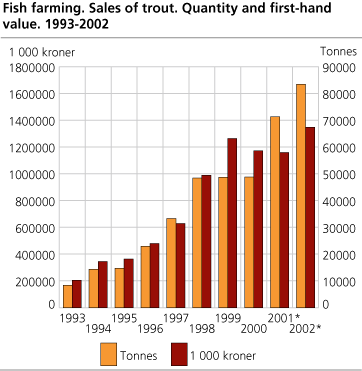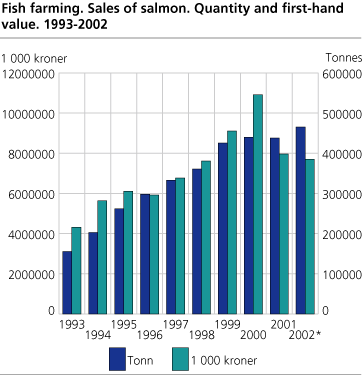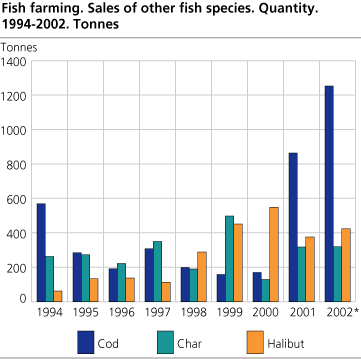Content
Published:
This is an archived release.
Larger volume to a lesser price
Preliminary figures for 2002 show that the total sales value of reared salmon and trout came to NOK 9.1 billion, the same as in 2001. The quantity sold was 549 000 tonnes, an increase of 7.7 per cent from the previous year. Prices on salmon and trout have declined.
Sales dropping
The value of salmon sold in 2002 came to NOK 7.7 billion, the lowest since 1998. The decline by 3 per cent is a result of lower prices. The average price fell from NOK 18.15 in 2001 to NOK 16.56 in 2002. A total of 465 000 tonnes of salmon were sold. This is the largest quantity ever and an increase of 6.2 per cent from 2001.
A total of 83 000 tonnes of trout were sold, up 17.1 per cent from 2001. The value of trout sold in 2002 came to NOK 1.4 billion, up 16.3 per cent from 2001. Both value and quantity are the highest ever registered. The average price fell marginally from NOK 16.38 in 2001 to NOK 16.16 in 2002
Nordland was still the salmon county no. 1 with 94 000 tonnes of salmon, while Hordaland produced the biggest quantity of trout, 23 500 tonnes.
Employment
The employment in fish farming in Norway has been stable since 1997. In 2002 there were 3 457 people employed, which made up almost 5 million man-hours.
Mainly men are employed in the production of salmon and trout. The portion of female workers has been stable for many years. In 2002, 15 per cent of all the employees were females, accounting for 9.4 per cent of all labour input. The number of female workers is larger in the production of fry and fingerlings than in the production of fish for consumption.
Loss/wastage in the production of fish for consumption
The number of salmon reported as lost/wastage in 2002 was over 29 million. This is an increase of 32.6 per cent from the previous year, but in proportion to the stocks - the loss/wastage was of the same magnitude as the year before. Around 95 per cent of these fish were counted and destroyed, while the rest had either escaped or been eaten by predators.
In 2002 about 629 420 farmed salmon and trout were reported escaped. This is the largest number reported since 1998. About 475 000 of these were salmons, an increase of 75 per cent compared with 2001. The number of escaped trouts in 2002 was reported to be 155 000, up 62 per cent from the previous year.
Biomass
The total biomass of fish in Norwegian fish farms increased. At the end of 2002 the stock of live salmon was 379 000 tonnes, as compared with 348 000 tonnes at the end of the previous year. There were 42 500 tonnes of live trouts in fish farms in 2002, a slight drop from 2001.
Cod increasing most
Fish farming of other fish species still lags far behind salmon and trout. Farmed cod is the third most important species measured by quantity. In 2002, 1 253 tonnes of farmed cod were sold; twice the quantity sold in 2001. Most of the cod is wild-caught and raised before sold (80 per cent). Sales of halibut increased from 376 tonnes in 2001 to 460 tonnes in 2002. Other fish species sold as farmed fish in 2002 were char, turbot, mackerel, saithe and eel.
Shellfish
Preliminary figures for 2002 show that sales have yet to take off. Mussels are still the main species; 2 467 tonnes were sold to a value of NOK 14.9 million.
Tables:
- Table 1 Fish farming. Sales of salmon and trout. Quantity and first-hand value. 2002
- Table 2 Fish farming. Salmon and trout. Number of workers and labour input, by type of licence. 2002
- Table 3 Fish farming. Salmon. Stock of fish for food during the period 1 January 2002 to 31 December 2002. 1 000 pieces
- Table 4 Fish farming. Salmon and trout. Stock of fish for food per 31 December 2002, by generation
Contact
-
Statistics Norway's Information Centre
E-mail: informasjon@ssb.no
tel.: (+47) 21 09 46 42



